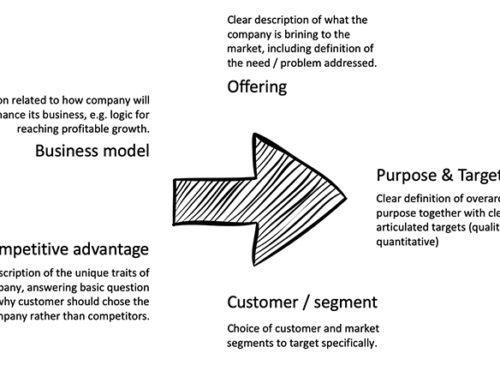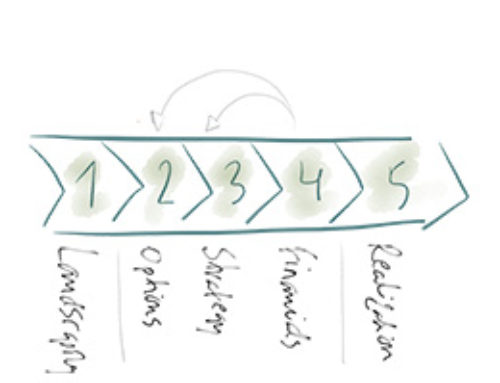The result of a well-articulated strategy should be visible in your company’s balance sheet and/or income statement. A strategy that does not result in concrete business results is useless. This philosophy is what we are referring to when we talk about value through strategy – concrete value delivered through a clearly articulated strategy.
However, in order to make this happen, you cannot stop once you have finalized the definition of your strategy. Thorough and complete realization of your strategy is the key to enabling value through strategy, and this is the point at which the strategy usually fails, for various reasons.
In this Insight on Strategy, we focus on the realization efforts; that is, all the things that need to happen once the strategy has been defined. We will share our perspective on the basic prerequisites, but also discuss what typically goes wrong.
Strategy realization seen as a great challenge
Strategy realization is one of the most challenging aspects of strategy. Developing a well-articulated strategy is one thing, but realizing its value is a completely different story. An example of a pertinent quotation regarding this topic, which underlines the importance of the realization effort, is from Percy Barnevik, the former CEO and later also Chairman of Asea Brown Boveri (ABB). In his recently published book, “Leadership – 200 advice” (Sanoma Utbildning, 2013-03), Barnevik said, “Good realization is 90 percent of the success, strategy 10”.
In 2by2’s 2013 strategy survey, we specifically asked about the challenges related to strategy (multiple options possible to select). According to the results of the survey, 14 percent of respondents believed that the analytical effort involved in a strategy was challenging. Close to 30 percent of respondents believed that the definition of strategy was challenging, while a further 30 percent believed that the strategy development process was a challenge. Close to half of respondents believed that identifying a competitive advantage represented a challenge, and 70 percent felt that the implementation of the strategy was part of the challenge of strategy. These remarkable results provide a clear message about the importance of dealing with the realization of the strategy in a serious way.

Components for being able to realize the strategy
There are basically five different components for being able to realize the strategy in an effective way. Firstly, the business plan is a tool with which to put the strategy in its relevant context. Secondly, key performance indicators (KPIs), are instrumental for ensuring that you are setting the right focus and prioritization in the organization. Thirdly, individual incentives clearly play an important role in ensuring that people make the correct prioritizations in their day-to-day business. The fourth area is change, which can be a somewhat ambiguous topic, but is a seriously important one when it comes to realization of the strategy. The final component is the follow-up mechanisms for the strategy realization effort.

Business plan
In previous insights on strategy, we have described our perspective on business planning and the key components of a business plan. In the context of strategy realization, the business plan is extremely important; this is where the strategy is put in the correct and full context of the company. The business plan should contain items such as key activities, dedicated responsibilities, qualitative and quantitative targets, prioritizations, realization approach, time plan, and capabilities required for realization.
Once the strategy has been finalized, activities regarding business planning should commence. Ultimately, this should result in a comprehensive, end-to-end business plan that lays the foundation for an effective strategy realization.
In terms of the business plan, it is not just the actual document itself that is important from a strategy realization perspective; equally important is the process leveraged to develop the business plan. If the process for developing the business plan is correctly set up, it should be inclusive and will therefore be an important component in making people truly understand and embrace the strategy; this is critical from a strategy realization perspective.
KPIs
There is a popular saying in business that says, “You get what you measure”. When correctly used, KPIs can be a very effective tool for supporting the realization of your strategy. Aligning the set of prioritized KPIs and the full scorecard of any company with the corporate strategy will help the organization realize the strategy by focusing on the right issues.
Incentives
In order to effectively realize the strategy, the individual incentives for the employees in the organization need to be fully aligned with the strategy. When correctly used, individual incentives can be among the most powerful and important tools when realizing a strategy. On the other hand, if individual incentives are not well aligned with the strategy, the implied strategic change is unlikely to occur.
Change
Despite numerous books about change, very few people have managed to master all aspects of change. It is clear, however, that without change, few strategies would be realized effectively. Ultimately, how difficult the aspects of change will be in any given case would be determined by the implied change of the strategy chosen and the willingness/readiness for change in the organization. One of the important things to remember about change is that in order to make change happen, any individual in their organization needs to support this strategy, both intellectually and emotionally; that is, with their brain and their heart.

Enablers of change
There are basically three major enablers of change: the story, the communication, and the ambassadors.
The story
The story is essential at the start. It should be a very high-level summary of the strategy and should be a summary tailored towards the different stakeholders in the organization, which means that it will probably need to be simplified, articulated and illustrated in a different way compared to the version presented in the boardroom. There is no silver-bullet solution for how to do this; it needs to consider the specific circumstances and culture in the company.
The communication
Once the story has been developed and finalized, it needs to be communicated within the organization. Communication is an essential part of enabling change. The key here is to realize that communication needs to be repeated in order to be effective.
The ambassadors
Ambassadors should be secured early on in the process. Ambassadors are people who fully understand the strategy, buy into it, and are able to speak about it. Ambassadors are also people who start to act the strategy, which means they demonstrate the change implied. The ambassadors becomes the change agents in any strategy realization effort. Members of the executive management team are automatically assumed to be ambassadors, but ambassadors should also be established at all levels in the organization.
Follow-up
In order for any strategy to be effectively realized, it must to be thoroughly followed-up. This means setting up a system of quantitative and qualitative measures that articulate the progress, both in terms of realization of the strategy and the business results achieved through the realization.
The follow-up mechanism helps focus the organization on the strategy realization and ensures that incentives are in line with the strategy. Without thorough follow-up mechanisms, the strategy could just become a good idea that never really is fully realized in the organization.
The platform/vehicle
One of the important aspects of strategy realization is to ensure that there is an effective platform, or vehicle, upon which the strategy can be realized. This essentially means ensuring at least three basic things: driver/owner, structure/process, and forum.
Driver/owner means that somebody needs to take responsibility for driving the realization of the strategy. Naturally, the strategy needs to be broadly supported and backed-up by the whole executive management team; in addition, someone must take on the driver role. This could, for instance, mean leading and facilitating the necessary strategy discussions, ensuring that everybody stays focused on realization of the strategy, and ensuring that the strategy remains on the agenda also after the initial period of strategy realization.
A strategy realization structure/process is a well-thought-through approach for how strategy realization should be executed. This means, for instance, an executive management team clearly agreeing on the step-by-step approach required to realize the strategy.
Finally, a strategy realization forum needs to be established. This can involve all or some of the executive management team, but it is usually a good idea to establish a strategy realization forum that involves other members of the organization. This is the forum where strategy realization discussions are held on a periodic basis, including clarifying uncertainties, following-up on progress, resolving key issues, and agreeing on next steps.
What typically goes wrong
Strategy realization is seen by many as the absolute key challenge when working with strategy. One reason for this is that there are so many things that can go wrong in this phase. Here we have outlined the most common issues that we have observed related to challenges in realization of strategy.

Lack of clarity
One of the most common issues in any effort involving realization of strategy is a lack of clarity. This could apply with a strategy that does not clearly articulate the key aspects of the strategy, such as offering, customers, competitive advantage, and business model, as described in earlier Insights on Strategy. Even with a clearly articulated strategy, the issue with lack of clarity could still exist; for instance, when it comes to describing the implications of the strategy, such as key changes implied by the strategy. If there is a lack of clarity around the strategy in itself and/or the implications of it, this usually leads to a poor realization. This issue typically indicates that the company has not fully managed to translate the strategy in to a comprehensive business plan, and/or that the communication efforts relating to the strategy has not been sufficient.
Lack of commitment
Strategy and its implications can be fully understood in the organization, but if there is no commitment behind it then this typically also leads to a poor strategy realization. In these cases, the rationale behind the strategy has not been strong enough, since people in organization do not fully believe that it is the right strategy for the company. The root cause of such issues could be found in the communication effort, but could also be due to poor simplification of the overarching strategy.
Underestimating the effort
Sometimes strategy realization fails simply because management underestimated the effort it would take to realize it. In these cases, although the strategy can be clear enough and the commitment might be there, the investment the organization is making in realizing the strategy is below the required level because it has underestimated the realization effort. Without a realistic estimation of the strategy realization effort, there is little chance that strategy will be effectively realized.
Lost focus and momentum
Finally, one of the most common issues with strategy realization is lost focus and/or momentum. This typically starts among executive management and can spread quickly to people who need to be involved in realizing the strategy at hand. In these cases, the strategy has been clearly articulated, commitment has been achieved throughout the organization, and the realization effort has been correctly estimated. The problem is a lack of persistence, since strategy realization is not achieved quickly in most cases. Executive management and the organization overall must remain focused on the strategy realization and keep the momentum at a high level. This can sometimes be quite challenging as several other business events might draw immediate attention away from the strategy.
Strategy realization in brief
A strategy that doesn’t result in a concrete business result that is visible in an income statement or a balance sheet, is basically useless. In order to realize concrete business result from any strategy, many believe that the realization effort is the key challenge in working with strategy. There are five basic components that must be secured in order to facilitate the strategy realization. The strategy, once clearly articulated and defined, should be formalized in a concrete business plan. Key performance indicators with a clear and direct link to the corporate strategy need to be established and prioritized, and personal incentives need to be consistently aligned throughout the organization. Finally, change needs to be enabled and follow-up mechanisms need to be established.
There are four common pitfalls in any strategy realization effort. The strategy might be ambiguous, which creates lack of clarity. Even with clarity, sufficient commitment might be missing and/or the strategy realization effort might be significantly underestimated. If executive management and the organization at large is not persistent enough, focus and momentum from the strategy realization effort will eventually be lost.
About Insight on Strategy
Strategy is one of the most overused and misused words in the business community. It is a term that everybody loves to use, but few dare to explain. 2by2 publishes Insights on Strategy to help companies improve their ability to create value through strategy by better understanding what strategy actually is, by learning how to spot the difference between a good strategy and a not-so-good strategy, and by gaining perspectives on the most common pitfalls when developing a strategy.
Previously published articles in this series:
A definition: http://www.2by2.se/insight-on-strategy-a-definition/
Competitive advantage: http://www.2by2.se/insight-on-strategy-competitive-advantage/
Strategy context: http://www.2by2.se/insight-on-strategy-the-strategy-context/
The good strategy: http://www.2by2.se/insight-on-strategy-the-good-strategy/
Strategy pitfalls: http://www.2by2.se/insight-on-strategy-strategy-pitfalls/
The strategy development process: http://www.2by2.se/insight-on-strategy-the-strategy-development-process/
The strategy development team: http://www.2by2.se/insight-on-strategy-the-strategy-development-team/
Competitor benchmarks and customer research: http://www.2by2.se/competitor-benchmarks-consumer-research/
Business planning: http://www.2by2.se/insight-strategy-business-planning/





Leave A Comment